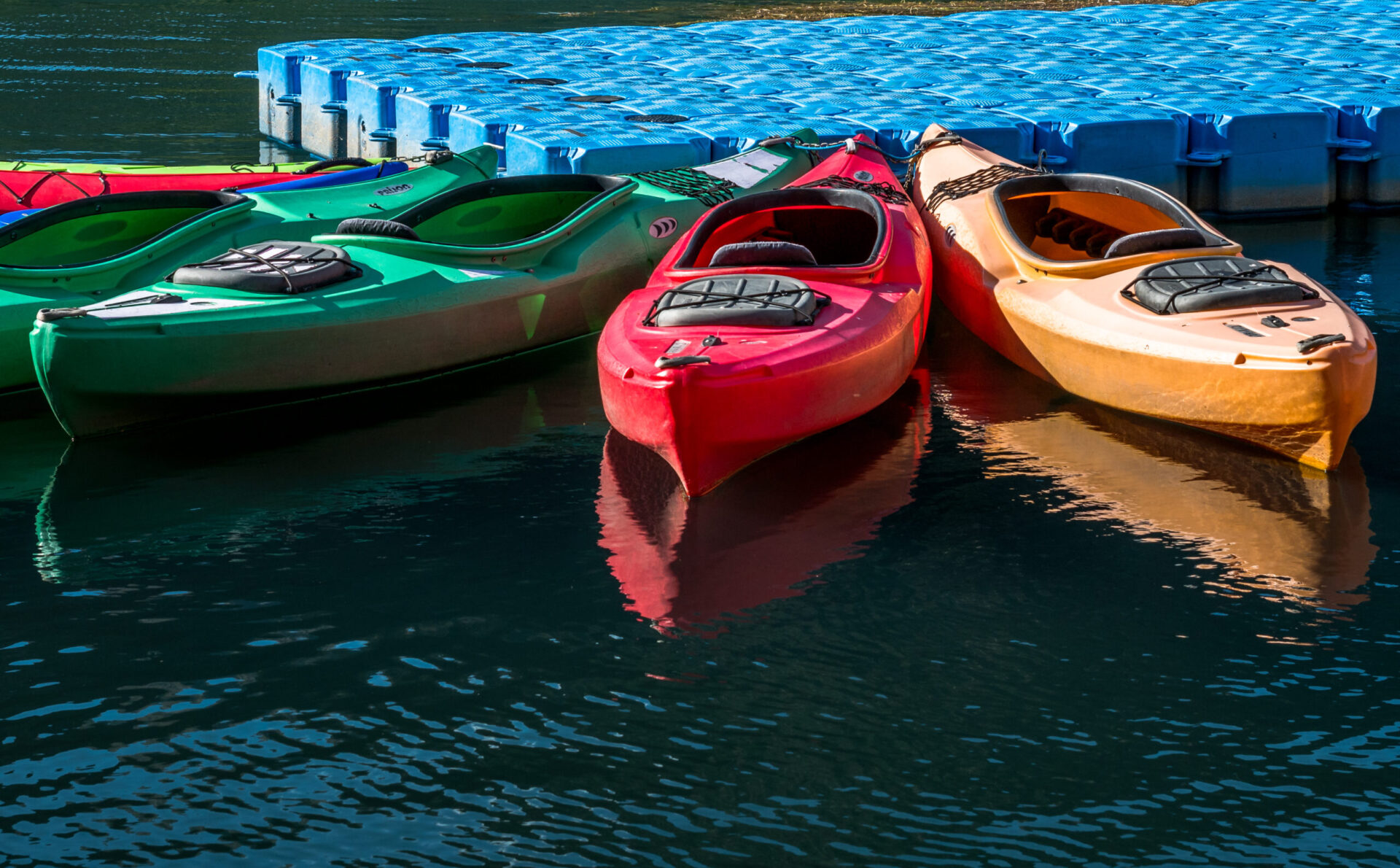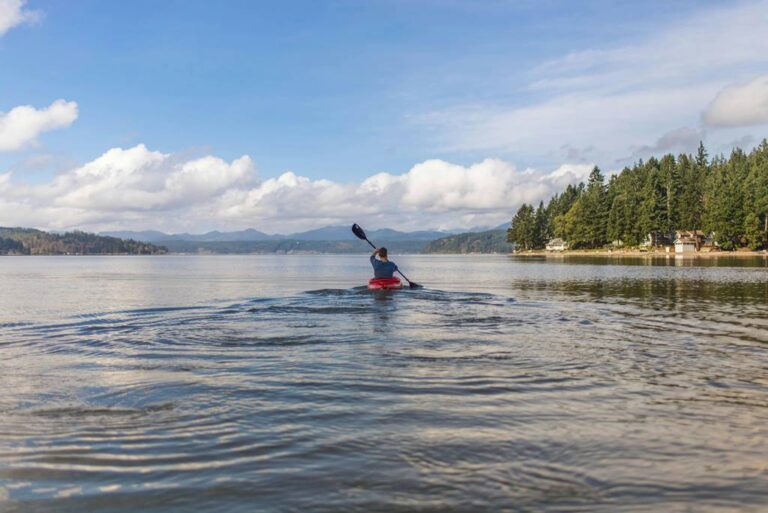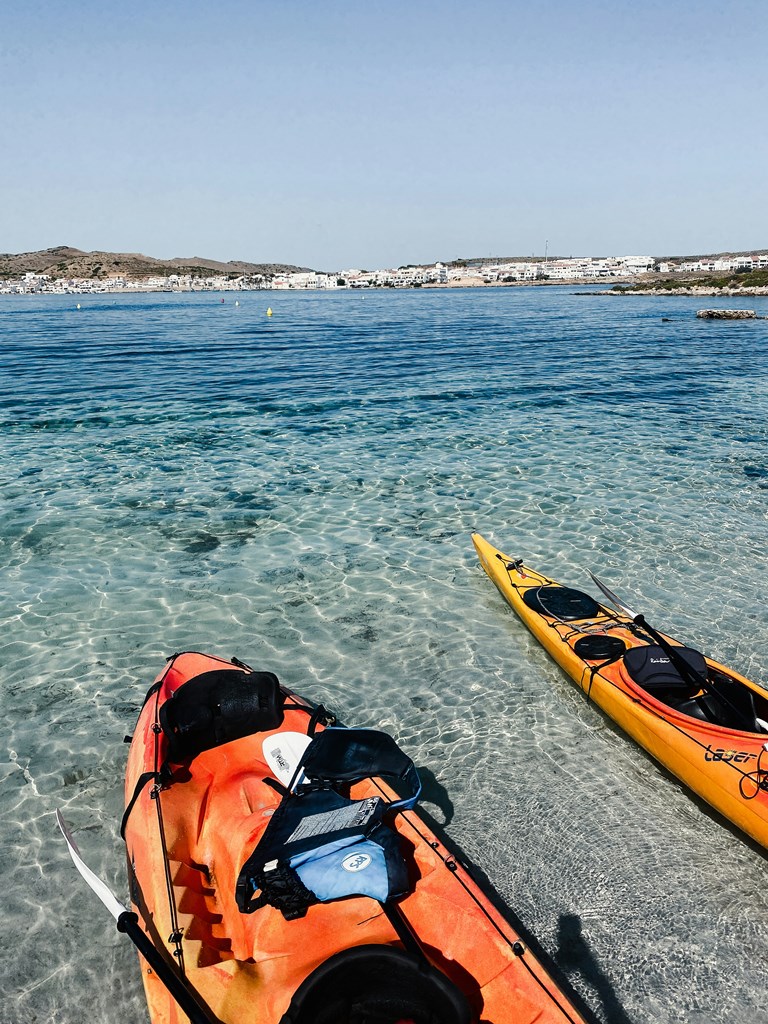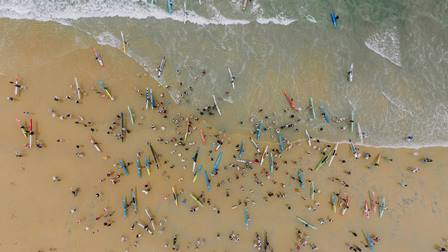
The thrill of kayaking awaits! But choosing your first (or next) kayak can be tough. This guide will help you navigate the world of inflatable and hard-shell kayaks, whether you’re a kayaking newbie or a seasoned pro. By understanding the strengths of each type, you’ll be able to pick the perfect kayak to fuel your aquatic adventures.
We’ll compare inflatable vs. hard-shell kayaks in their performance, durability, portability, and more to help you choose the perfect match for your kayaking adventures. We’ll cover everything from setup time and cost to how easy they are to fix and maintain, keeping safety and environmental impact in mind too.
Table of Contents
The Impact of Water Conditions on Kayak Performance
Choosing the right kayak for your adventure depends on how it cuts through the water and that varies based on the materials used. Inflatable and hard-shell kayaks each have unique strengths, so understanding their differences will lead to a smooth and safe kayaking experience.
Get Started: The Basic
Not all kayaks are created equal! Whether you choose an inflatable kayak or a traditional hard-shell one, the design and material play a big role in how it handles different water conditions (calm lakes, choppy rivers, etc.). Understanding these strengths and weaknesses will help you pick the perfect kayak for a fun and safe paddling adventure!
Inflatable Kayaks: Stable & Smooth on Calm Waters
Inflatable kayaks are a perfect fit for tranquil adventures. Their buoyant design and wider hull provide exceptional stability on placid lakes, gentle rivers, and even mild whitewater. This translates to a smooth, comfortable paddling experience. A friend who was new to kayaking recently enjoyed a serene exploration of a local lake in an inflatable. The kayak’s stability and gentle ride were perfect for allowing him to focus on the sights and sounds around him.
Hard-Shell Kayaks: Slice Through Waves with Confidence
In contrast, hard-shell kayaks thrive in rough waters thanks to their rigid build and sleek design. Their excellent stability and manoeuvrability make them the weapon of choice for conquering waves and navigating challenging whitewater. This advantage becomes clear on the water. They slice through the rapids with impressive control, a feat that is impossibly difficult in an inflatable.
Matching Your Paddle to the Water
While the type of kayak plays a big role, your paddling skills and the water conditions you’ll face are equally important. Understanding a kayak’s strengths and weaknesses is key to a safe and fun adventure. For example, if you’re a seasoned paddler planning to tackle everything from calm lakes to wild rapids, an inflatable kayak’s versatility might be perfect. But remember, inflatables demand a certain skill set for safe handling. On the other hand, if you’ll mostly be paddling rough seas or challenging rivers, a hard-shell kayak might be ideal thanks to its stability and control.
Strength and Lifespan: The Durability of Kayaks
Durability is a key concern when picking your kayak. It boils down to how well it resists damage and how long it holds up to regular paddling. While both inflatable and hard-shell kayaks are built for water adventures, their toughness can vary greatly. This difference depends on the materials used and how they’re put together.
Built to Last? Inflatable vs. Hard-Shell Durability
Picking a kayak? Durability is a big deal! Both inflatable and hard-shell kayaks are built to handle water, but how well they resist wear and tear can be quite different. Here’s the breakdown:
- Material Matters: Inflatable kayaks are made of tough PVC or Hypalon, but can be punctured. Hard-shell kayaks come in plastic, fiberglass, or even carbon fiber, offering more puncture resistance.
- Built to Last: Construction methods also play a role. High-quality inflatables with drop-stitch floors can be very durable, while hard-shell kayaks require more maintenance to keep them in top shape.
Durability of Hardshell Kayaks
The tough exteriors of hard-shell kayaks, crafted from plastic, fibreglass, or carbon fibre, shrug off bumps and scrapes from rocks, branches, and other kayaking hazards. This rigid construction makes them ideal for navigating challenging waters where unexpected obstacles might lurk.
The following are some common materials used in hard-shell kayaks:
| Material | Durability | Weight | Cost |
|---|---|---|---|
| Polyethylene | High | Heavy | Lower |
| ABS (Acrylonitrile Butadiene Styrene) | Medium-High | Medium | Moderate |
| Composite (Fiberglass, Carbon Fiber, Kevlar) | High | Light-Very light | High-Highest |
Inflatable Kayaks Durability
While inflatable kayaks are built with tough, puncture-resistant materials like PVC or Hypalon, they can experience wear and tear faster than hard-shell kayaks, especially with frequent use in rough conditions or if proper maintenance is neglected.
The following are some common materials used in inflatable kayaks:
| Material | Durability | Weight | Cost |
|---|---|---|---|
| PVC (Polyvinyl Chloride) | Medium | Light-Medium | Lower |
| Hypalon | High | Medium | Higher |
| Nitrylon | High | Heavy | Moderate |
The Importance of Maintenance for Kayak Longevity
Besides its construction, the lifespan of your kayak heavily depends on maintenance and care practices. Regular cleaning, correct storage, and vigilant checks for damage signs can significantly prolong the lifespan of both inflatable and hardshell kayaks.
Ease of Portability and Storage: Exploring Convenience
Comparing Portability:
Inflatable kayaks offer a significant advantage over hardshell models in terms of portability. They can be deflated and compactly packed into a duffel bag or backpack, catering to those who require convenient travel with their kayak.
According to a survey conducted by the Outdoor Industry Association, 32% of paddlers valued the effortless transportation of inflatable kayaks in contrast to their hardshell counterparts. This ease of transport not only simplifies the journey to the water but also expands the possibilities for kayaking locations. With an inflatable kayak, you can venture on planes, hikes, or even bicycle rides, enhancing your kayaking adventures.
Hard-Shell Kayaks: Tough Choice for Tight Spaces
Hard-shell kayaks are super durable, but getting them to the water can be a hassle. Here’s why:
- Size and Weight: They can be long (10-16 feet!) and heavy (35-85 lbs!), making them tough to fit in a car without a roof rack or trailer. Not ideal for city dwellers or those without a big truck.
- Storage Struggle: Forget shoving them in a closet! Hardshell kayaks need dedicated space, like a garage, and a dry, shaded spot to keep them in good shape. Apartment living might not be the best fit.
Inflatable Kayaks: Easy Transport, Easy Storage (But…)
Inflatable kayaks win big on portability and storage:
- Pack and Go: Deflate them, and they fit in a bag! Perfect for car trunks or small apartments.
- Storage Savvy: No need for a giant garage. Just deflate and store them away when not in use.
Remember: There’s a trade-off. While inflatables are easier to move and store, they may not perform as well or be as durable as hard-shell kayaks. Choose the one that best fits your kayaking needs and lifestyle!
Quick and Easy Setup: Get on the Water Faster!
When contemplating buying a kayak, it’s vital to assess the simplicity and convenience of the setup process. Both inflatable and hardshell kayaks possess distinct features that impact their ease of use and setup, making it imperative to grasp the specifics of each type. So it’s crucial to understand what each type entails.
Inflatable Kayaks: Backpack to Beach in Minutes!
inflatable kayaks are all about convenience. Deflated, they fit snugly in a backpack or car trunk, taking up minimal space. Setting up is a breeze – just inflate them with a pump (most take just minutes!), and with many models featuring electric pumps, it’s even easier. Once inflated, they’re surprisingly light, making carrying them to the water a snap.
But convenience isn’t all they offer! Many inflatables come with adjustable seats for comfort, and some even have rudders or skegs for improved tracking in the water. Plus, packing them away after your adventure is just as quick and simple.
Hard-Shell Kayaks: Tough Performance, More Setup Involved
Hard-shell kayaks might not be as packable, but they shine in performance and durability. However, their size and weight often require a roof rack or trailer for transportation. This means securing the kayak to your car, driving to your paddling spot, then unloading and carrying it to the water – a process that can be time-consuming and physically demanding, especially for solo paddlers.
Setting up a hard-shell kayak can also involve additional steps depending on the model and features. This might include adjusting seats or attaching a rudder or skeg (if not built-in). Despite the extra setup, many kayakers appreciate the rock-solid build and performance of hard-shell kayaks, finding the setup process a worthwhile trade-off.
Remember: While setup takes longer with hard-shell kayaks, many kayakers love their sturdiness and performance, making the extra effort worthwhile.
Budgeting for Your Kayak: Considering Costs and Needs
Beyond the Sticker Price: The True Cost of Kayaking
The price tag isn’t the only number to consider when choosing a kayak. Think about the long haul! Ongoing maintenance, potential repairs, and how well the kayak meets your needs all play a role in the total cost of ownership. Let’s dive into the cost considerations for both inflatable and hard-shell kayaks.
Inflatable Kayaks: Budget-Friendly Fun
Generally, inflatable kayaks are more affordable, making them a great choice for beginners or casual paddlers. Prices range from:
- $100-$300: Basic models for calm water adventures.
- Up to $1000+: High-end models for more challenging conditions, with advanced features.
Despite their affordability, inflatables can still offer good performance, comfort, and portability. They’re a great value for the price!
Hard-Shell Kayaks: Investment for Serious Paddlers
Hardshell kayaks typically cost more due to their sturdy build, durability, and better performance. Prices vary depending on the type (recreational, touring, etc.), material (plastic, fiberglass), and brand:
- $300 and Up: Recreational kayaks for flatwater fun.
- Thousands: Specialized sea or touring kayaks for serious adventures.
While the upfront cost is higher, a hardshell kayak can be a worthwhile investment for frequent paddlers or those tackling rougher waters.
Don’t Forget the Extras!
Both types of kayaks might require additional gear:
- Paddles
- Life vests
- Pumps (for inflatables)
- Roof racks (for hard-shells)
Maintenance costs also differ. While inflatables are generally easier to maintain, they might require patching punctures. Hardshell kayaks generally need less maintenance but repairs for cracks or damage can be expensive.
Choosing Your Kayak: Value for Your Needs
The best kayak for you depends on your budget and paddling style. Inflatables offer affordability and convenience, while hard-shells provide top performance and durability. Consider your needs and long-term goals to find the kayak that gives you the most value for your money!
Kayak Care Essentials: Ensuring Longevity Through Maintenance and Repairs
Taking care of your kayak keeps it performing well and lasting longer. Here’s what to expect for each type:
Inflatable Kayaks: Cleanliness is Key!
Since inflatables are fabric, keeping them clean and dry is super important:
- Rinse After Every Paddle: Especially after saltwater or mud! This removes dirt that can damage the material.
- Dry it Out Completely: Don’t put it away wet! Moisture can lead to mold and mildew.
- Check for Wear and Tear: Look at the seams regularly for any small tears.
Inflatable Repairs: DIY Doctor
Fixing minor punctures or leaks is often a DIY project you can tackle yourself! Most inflatable kayaks come with a handy repair kit, including patches and adhesive. The process is usually pretty straightforward: just clean and dry the damaged area, and then apply the patch according to the instructions. However, for larger tears or seam separations, it’s best to consult a professional repair service to ensure a proper fix that maintains the kayak’s integrity.
Hard-Shell Kayaks: Less Fuss, More Muscle
Hard-shell kayaks are tough, so maintenance is pretty simple:
- Quick Rinse After Use: Keeps your kayak looking good.
- Deep Clean Occasionally: Use mild soap and water for stubborn dirt.
Hard-Shell Repairs: Can Get Tricky
Cracks or damage to a hard-shell kayak might need a professional or a special repair kit depending on the material (plastic, fibreglass, etc.). These repairs can be more complex than fixing an inflatable.
Remember: The best maintenance plan is the one you’ll do! Choose a kayak that fits your comfort level for upkeep.
Paddle Safe, Paddle Smart: Safety Tips for All Kayakers
No matter what kayak you choose, safety is always the top priority. Both inflatables and hard shells can be safe choices, but it depends on how you use them and what safety gear you have on board.
Hard-Shell Kayaks: Carving Cautiously Through Rough Waters
Hardshell kayaks are generally more stable due to their rigid design. This makes them a good choice for rougher conditions like oceans or whitewater, where tipping over is a bigger risk. The extra stability can give you more confidence and control when paddling in challenging environments.
Inflatable Kayaks: Ideal for Calm Adventures
Inflatable kayaks, while wide and low for stability, can be more affected by wind and waves due to their lighter weight. This makes them a better choice for calmer waters like lakes or slow-moving rivers. But that doesn’t mean they’re unsafe! Used correctly, they can provide a fun and relaxing paddling experience.
Safety Gear: Everyone’s Must-Haves
Here’s what every kayaker, regardless of kayak type, should have:
- Life Jacket (PFD): It’s your best friend on the water! According to the U.S. Coast Guard, most drowning victims in boating accidents weren’t wearing one.
- Whistle: A loud whistle can attract attention if you need help.
- Headlamp/Flashlight: Essential for paddling after dark or in low-light conditions.
- Proper Clothing: A drysuit or wetsuit might be needed for colder water.
Know Your Limits, Choose Wisely
Be honest about your paddling skills. Don’t venture into rough water if you’re used to calm lakes. Choose a kayak and paddling environment that matches your experience level.
Safety Courses: Invest in Knowledge
Taking a kayaking safety course can significantly improve your safety on the water. You’ll learn valuable skills like navigation, rescue techniques, and proper paddling form. Studies by the American Canoe Association show that kayakers with safety training are less likely to be involved in accidents.
Remember: While hard-shell kayaks might be more stable in rough conditions, inflatables can also be safe when used appropriately. Always prioritize safety by using the right gear, paddling within your limits, and considering safety training. This will ensure your kayaking adventures are both fun and worry-free!
Paddling Green: The Environmental Impact of Kayaks
As eco-conscious kayakers, choosing the right gear matters. Let’s explore how inflatable and hard-shell kayaks impact the environment throughout their lifecycles:
Production Process: Keeping Your Footprint Light
Inflatable kayaks generally win in the eco-race when it comes to production. Here’s why:
- Lighter Materials: They’re made of PVC or Hypalon, requiring less energy to produce than materials used in hard-shell kayaks.
- Fuel-Efficient Transport: Their lighter weight means less fuel is needed to transport them from factory to store, reducing their carbon footprint.
Hard-shell kayaks, especially those made of fibreglass or carbon fibre, can have a higher carbon footprint due to the energy-intensive manufacturing process.
Lifespan and Durability: Built to Last?
While production might be less eco-friendly, hard-shell kayaks can last for decades with proper care. This reduces the need for replacements and lowers their overall environmental impact. Imagine John, a kayaker who’s been using his dad’s trusty hard shell for over 25 years! Hardshells can become family heirlooms, decreasing demand for new kayaks.
Disposal and Recyclability: The Final Journey
The end of a kayak’s life matters too. Here’s how they differ:
- Inflatable Kayaks: Easier on Landfills: Made from recyclable materials like PVC, they can be broken down and reused, reducing waste.
- Hard-Shell Kayaks: Recycling Challenges: Composite hard-shell kayaks can be difficult to recycle and might end up in landfills if not disposed of properly.
However, there’s hope! Outdoor gear exchange programs are popping up, offering more sustainable disposal solutions for hard-shell kayaks.
Choosing Your Eco-Friendly Paddle
Both kayak types have environmental upsides and downsides. Consider your paddling style and commitment:
- Frequent Paddler with Long-Term Plans? A durable hard-shell kayak, if properly cared for, can minimize the need for replacements over time.
- Occasional Paddler Prioritizing Easy Disposal? An inflatable kayak might be the greener choice due to its recyclable materials.
Remember, the most eco-friendly kayak is the one you’ll use and care for for years to come!
Easy Transport or Rock-Solid Stability? Portability and Storage Explained
When choosing a kayak, portability and storage are key factors to consider. Here’s how inflatable and hard-shell kayaks differ:
Inflatable Kayaks: Pack and Go Paddling
Inflatable kayaks are champions of portability. They deflate and fold into compact bags, ideal for:
- Limited Storage Space: Live in an apartment? No problem! Inflatable kayaks are stored easily in closets or even car trunks.
- Small Vehicles: No big truck? Inflatable kayaks fit in most cars, making them perfect for day trips.
- Travel Buddies: Deflated, they’re great for checking as luggage on flights or taking on long road trips.
- Remote Adventures: Lightweight and packable, they’re ideal for hikes to hidden paddling spots.
Imagine Sarah, a travel blogger, who explores the world with her inflatable kayak. She easily checks it on flights and paddles stunning locations worldwide!
Hard-Shell Kayaks: Tough and Steady, But Bulky
Hard-shell kayaks offer superior stability and performance, but their size and weight come at a cost:
- Transportation: Roof racks are usually needed for transport, limiting vehicle options.
- Storage: They require dedicated storage space, like a garage or shed, which might not be available in apartments.
For example, Michael, a city kayaker, struggled to store his 12-foot hard shell in his small apartment. He ended up renting a storage unit, adding an unexpected expense.
Your Kayak Adventure Starts Here: Choose Wisely!
Choosing a kayak shouldn’t be a headache. By understanding your paddling style and preferences, you can unlock a world of enjoyment on the water. Find the kayak that fits your life and get ready for countless adventures!
- Frequent Paddler with Limited Storage? An inflatable kayak offers unmatched portability and storage convenience.
- Performance-Focused Paddler with Storage Space? A hard-shell kayak provides stability and top-notch paddling experiences.
Remember, the ideal kayak is the one that fits your paddling style and storage situation. Consider your priorities to find your perfect match!
Paddle Perfect: Choosing Your Ideal Kayak
Finding the right kayak can seem overwhelming, but it doesn’t have to be! By understanding your needs and priorities, you can choose the kayak that will unlock countless hours of watery fun.
Performance vs. Convenience: Striking the Right Balance
Are you a thrill-seeker prioritizing speed and stability, or a casual paddler valuing portability and storage? Here’s how inflatable and hard-shell kayaks cater to different styles:
- Hard-Shell Kayaks: Rock-Solid Performance For kayakers who crave top-notch performance and durability, hard-shell kayaks reign supreme. They offer excellent tracking, stability, and a smooth ride, making them ideal for longer trips or challenging waters. However, their size and weight can make transportation and storage a hurdle, especially for those with limited space.
- Inflatable Kayaks: Easy Transport, Easy Storage Inflatable kayaks are champions of convenience. They deflate into compact bags, perfect for storing in apartments, car trunks, or even taking on flights. Their lightweight design makes them ideal for quick getaways or exploring remote paddling destinations. While they might not match the performance of hard-shells in rough water, they’re great for calm lakes and leisurely paddling.
Consult Experts and Peers
Kayaking forums, expert blogs, and even friendly folks at outdoor stores are treasure troves of knowledge. Read user reviews and ratings too. Real kayakers offer valuable insights that go beyond specs.
Finally, consider a trial run! Renting different kayak types or borrowing from friends allows you to test out various models and materials before committing to a purchase. This hands-on experience can help you discover which kayak feels most comfortable and enjoyable to paddle.
The Perfect Paddle Partner Awaits, Error: It’s Part of the Plan!
Finding your perfect kayak isn’t a one-shot deal. Don’t be afraid to experiment! Consider renting or borrowing different models before you buy. Test out various materials and styles to see what feels best. The right kayak should fit your needs and lifestyle, and most importantly, make you excited to paddle! Take your time, do your research, and soon you’ll be cruising the water with your ideal paddling companion.
Frequently Asked Questions: Inflatable vs. Hard-Shell Kayaks
Q: Are inflatable kayaks as good as hard ones?
A: Inflatable kayaks can be great alternatives! They’re easier to transport and store, and new designs are quite durable for various water conditions. However, hard-shell kayaks generally offer more speed and maneuverability.
Q: Which is better: inflatable or hard-shell kayak?
A: It depends on your needs!
- Hard-shell kayaks excel in performance, durability, and offer a traditional paddling experience.
- Inflatable kayaks are ideal for portability, storage, and flexibility.
Q: What are the disadvantages of inflatable kayaks?
A: Inflatable kayaks trade some durability for portability. Punctures are a possibility, but high-quality models offer surprising toughness for most recreational paddling. They may also track less efficiently due to their lightweight design. However, this trade-off can be worth it for their ease of storage and transport.
Q: What are the disadvantages of hard-shell kayaks?
A: Hard-shell kayaks reign supreme in durability and tracking but come with trade-offs. They’re bulky and require roof racks or trailers for transport, making spontaneous adventures trickier. Storage can also be a challenge due to their size.
Q: Are inflatable kayaks a good idea?
A: Absolutely! They’re perfect for limited storage space or those who prefer a lightweight and easy-to-transport option. They’re also great for calm waters, short trips, or recreational paddling.
Q: How long do inflatable kayaks last?
A: It depends on material quality, usage frequency, and care. High-quality inflatables with proper care can last 5-10 years or more.
Q: How long does a hard-shell kayak last?
A well-maintained hard-shell kayak can last a lifetime! The factors affecting their lifespan are the quality of material, proper storage, maintenance and care etc. Some reports suggest a typical lifespan of 6-12 years, but with good care, a hard-shell kayak can surpass that and become a cherished companion for many years on the water.
Q: Can inflatable kayaks handle rough waters?
A: While typically suited for calm waters, some high-end inflatable models are designed for rougher conditions. Always choose a kayak appropriate for the water conditions you plan to encounter, and prioritize safety above all else.






